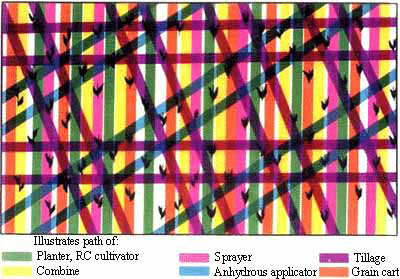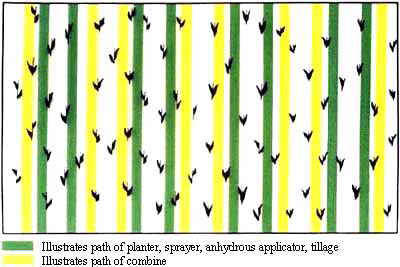Controlled Traffic
The goal of controlled traffic is to confine soil compaction to smaller portions of the field.
Introduction
What is controlled traffic?
Controlled traffic is the practice of running farm machinery over the same paths in the field, from event to event and year to year, so that compaction resulting from such passes will be confined to the smallest possible proportion of the field. The theory of controlled traffic is illustrated in the following figures obtained from the University of Nebraska:
Random wheel traffic patterns (top) create compaction over the majority of the field as compared to controlled wheel traffic (bottom).


Why do it?
Possible benefits include improved water infiltration and root growth, as well as a reduction in fuel costs associated with tilling compacted soils. Observations and experimental results from Nebraska, Ohio, and Australia suggest that these benefits do not occur in all situations:
From University of Nebraska extension:
- In a single year, nearly 90% of a field is compacted by normal field operations using a conventional tillage system.
- 80% of soil compaction from wheel traffic occurs on the first pass of a tire.
- In a 1980’s survey, about 40% of fields had some compaction; only about 10% of the fields had compaction severe enough to cause yield reductions.
- Compaction can reduce yields up to 60% depending upon the depth of compaction and its severity.
- Compaction has been shown to persist up to 9 years when it is very severe and deep in the soil profile; persistence for three to four years is common.
From the University of Queensland:
- Up to half the power output of a tractor doing normal tillage is used in compacting soil and breaking up it’s own wheel tracks.
- After five seasons of controlled traffic, yields increased an average of 16%
From Ohio (Lal and Ahmadi, 2000).
- Controlled traffic led to a 5% decrease in average yield over an 11-year period compared to typical traffic operations
- No differences in bulk density, soil penetration, and soil moisture content between regular and controlled traffic.
Why doesn't everybody do it?
Adoption of controlled traffic is probably most limited by incompatibility of farm equipment (e.g., different wheel spacings between planters and harvesters). Contradictory yield results, as shown above, or even just the perceived lack of benefits also inhibit adoption.
Controlled traffic is likely to have the most beneficial effect on fine-textured soils in wetter regions, but such site-specific recommendations need further research. Even without yield improvement, controlled tillage may still be worthwhile, if it reduces fuel costs.
Back to topBackground
How is soil affected?
Approximately 80% of soil compaction from wheel traffic occurs on the first pass of a tire, so the second pass of a tire will cause less compaction if it is run over the same track rather than a new area. Compaction not only diminishes soil quality but has an energy cost as well. Extra energy is expended by the tractor to both compact and till the compacted soil. Energy is also saved because wheels get better traction on compacted soil.
Compaction reduces total porosity in the soil and disproportionately reduces the number of larger pores compared to smaller pores. This may result in less infiltration, diminished water-storage capacity, and inhibited root growth. See “compaction” for more information.
Online resources for more background information:
Soil Compaction: The Silent Thief (from U. of Missouri-Columbia). An overview of compaction, not controlled tillage. http://muextension.missouri.edu/xplor/agguides/agengin/g01630.htm
Management Strategies to Minimize and Reduce Soil Compaction (University of Nebraska Extension). http://ianrwww.unl.edu/pubs/soil/g896.htm#cwt
Controlled Traffic Farming. An overview in question and answer format from Australia.
http://www.dpi.qld.gov.au/fieldcrops/3340.html
Home page of the Controlled Traffic Project in Australia. Perhaps the most extensive research project on the topic. An e-mail address is available for asking specific questions.
http://www.uq.edu.au/~gajtullb/control_traffic/index.htm
Controlled Traffic Farming. Table of contents from Australian publication on conservation farming, with chapter (in PDF) on controlled traffic. http://www.agric.nsw.gov.au/reader/6086
How to monitor the soil
To evaluate the effects of adoption, indicators need to be measured both in and outside of controlled traffic paths. Soil quality indicators that may indicate a need to adopt the practice or that can be used to monitor its effects include:
Bulk density (the inverse of porosity)
Infiltration
Root growth patterns
Yield
Local considerations
The severity of soil compaction caused by the farm machinery depends on the soil moisture content, axle load, and texture (McCormak, 1987). Controlled traffic is likely to have the most beneficial effect on heavy-textured soils in wetter regions, but such site-specific recommendations need further research. Surface compaction may also be less of a problem in regions with several freeze-thaw cycles during the winter.
Back to topRegion-specific data:
Back to topHow-to
Wheel compatibility between planter, sprayer, and harvester is the main issue in establishing controlled traffic. The following online resources address this obstacle:
Selecting and Sizing Combine Drive Tires
http://www.ianr.unl.edu/pubs/farmpower/nf300.htm
Equipment Wheel Spacing for Ridge-Till and No-Till Row Crops
http://www.ianr.unl.edu/pubs/farmpower/ec780.htm
Options for controlling traffic with incompatible equipment, from Australia
http://www.uq.edu.au/~gajtullb/control_traffic/traffic.htm
Real experiences
Back to topOther resources
Traffic effects on water availability:
Li Y.X., J.N. Tullberg, and D.M. Freebairn. 2001. Traffic and residue cover effects on infiltration. Australian Journal of Soil Research 39 (2): 239-247.
Tullberg J.N., P.J. Ziebarth, Y.X. Li . 2001. Tillage and traffic effects on runoff. Australian Journal of Soil Research 39 (2): 249-257.
Tullberg J.N. 2000. Wheel traffic effects on tillage draught. Journal of Agricultural Engineering Research 75 (4): 375-382.
Axle load effects on soil compaction and crop yield:
Lal R. and M. Ahmadi. 2000. Axle load and tillage effects on crop yield for two soils in central Ohio. Soil and Tillage Research 54 (1-2): 111-119.
Hadas, A. 1994. Soil Compaction caused by high axle loads: Review of concepts and experimental data. Soil and Tillage Research29 (2-3): 253-276.
General effects of soil compaction:
Chamen, W., G.D. Vermeulen, D.J. Campbell, and C. Sommer. 1992. Reduction of traffic-induced soil compaction: A synthesis. Soil and Tillage Research 24 (4): 303-318.
McCormak, D.E. 1987. Land evaluations that consider soil compaction. Soil Tillage Res. 10, pp. 21-27.
Back to top
